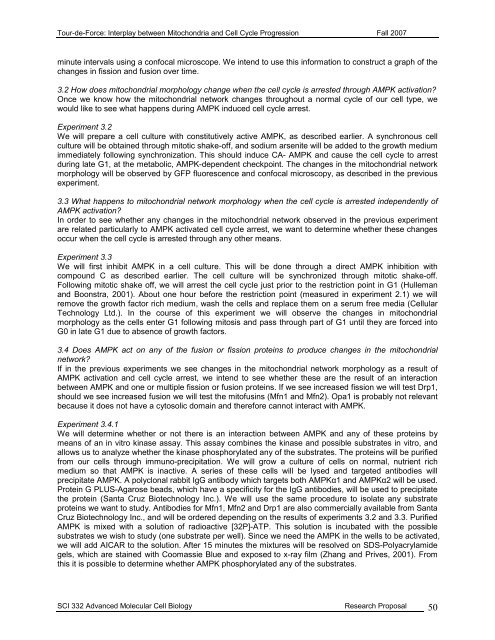Tour-de-Force
Tour-de-Force
Tour-de-Force
Create successful ePaper yourself
Turn your PDF publications into a flip-book with our unique Google optimized e-Paper software.
<strong>Tour</strong>-<strong>de</strong>-<strong>Force</strong>: Interplay between Mitochondria and Cell Cycle Progression Fall 2007minute intervals using a confocal microscope. We intend to use this information to construct a graph of thechanges in fission and fusion over time.3.2 How does mitochondrial morphology change when the cell cycle is arrested through AMPK activation?Once we know how the mitochondrial network changes throughout a normal cycle of our cell type, wewould like to see what happens during AMPK induced cell cycle arrest.Experiment 3.2We will prepare a cell culture with constitutively active AMPK, as <strong>de</strong>scribed earlier. A synchronous cellculture will be obtained through mitotic shake-off, and sodium arsenite will be ad<strong>de</strong>d to the growth mediumimmediately following synchronization. This should induce CA- AMPK and cause the cell cycle to arrestduring late G1, at the metabolic, AMPK-<strong>de</strong>pen<strong>de</strong>nt checkpoint. The changes in the mitochondrial networkmorphology will be observed by GFP fluorescence and confocal microscopy, as <strong>de</strong>scribed in the previousexperiment.3.3 What happens to mitochondrial network morphology when the cell cycle is arrested in<strong>de</strong>pen<strong>de</strong>ntly ofAMPK activation?In or<strong>de</strong>r to see whether any changes in the mitochondrial network observed in the previous experimentare related particularly to AMPK activated cell cycle arrest, we want to <strong>de</strong>termine whether these changesoccur when the cell cycle is arrested through any other means.Experiment 3.3We will first inhibit AMPK in a cell culture. This will be done through a direct AMPK inhibition withcompound C as <strong>de</strong>scribed earlier. The cell culture will be synchronized through mitotic shake-off.Following mitotic shake off, we will arrest the cell cycle just prior to the restriction point in G1 (Hullemanand Boonstra, 2001). About one hour before the restriction point (measured in experiment 2.1) we willremove the growth factor rich medium, wash the cells and replace them on a serum free media (CellularTechnology Ltd.). In the course of this experiment we will observe the changes in mitochondrialmorphology as the cells enter G1 following mitosis and pass through part of G1 until they are forced intoG0 in late G1 due to absence of growth factors.3.4 Does AMPK act on any of the fusion or fission proteins to produce changes in the mitochondrialnetwork?If in the previous experiments we see changes in the mitochondrial network morphology as a result ofAMPK activation and cell cycle arrest, we intend to see whether these are the result of an interactionbetween AMPK and one or multiple fission or fusion proteins. If we see increased fission we will test Drp1,should we see increased fusion we will test the mitofusins (Mfn1 and Mfn2). Opa1 is probably not relevantbecause it does not have a cytosolic domain and therefore cannot interact with AMPK.Experiment 3.4.1We will <strong>de</strong>termine whether or not there is an interaction between AMPK and any of these proteins bymeans of an in vitro kinase assay. This assay combines the kinase and possible substrates in vitro, andallows us to analyze whether the kinase phosphorylated any of the substrates. The proteins will be purifiedfrom our cells through immuno-precipitation. We will grow a culture of cells on normal, nutrient richmedium so that AMPK is inactive. A series of these cells will be lysed and targeted antibodies willprecipitate AMPK. A polyclonal rabbit IgG antibody which targets both AMPKα1 and AMPKα2 will be used.Protein G PLUS-Agarose beads, which have a specificity for the IgG antibodies, will be used to precipitatethe protein (Santa Cruz Biotechnology Inc.). We will use the same procedure to isolate any substrateproteins we want to study. Antibodies for Mfn1, Mfn2 and Drp1 are also commercially available from SantaCruz Biotechnology Inc., and will be or<strong>de</strong>red <strong>de</strong>pending on the results of experiments 3.2 and 3.3. PurifiedAMPK is mixed with a solution of radioactive [32P]-ATP. This solution is incubated with the possiblesubstrates we wish to study (one substrate per well). Since we need the AMPK in the wells to be activated,we will add AICAR to the solution. After 15 minutes the mixtures will be resolved on SDS-Polyacrylami<strong>de</strong>gels, which are stained with Coomassie Blue and exposed to x-ray film (Zhang and Prives, 2001). Fromthis it is possible to <strong>de</strong>termine whether AMPK phosphorylated any of the substrates.SCI 332 Advanced Molecular Cell Biology Research Proposal 50
















